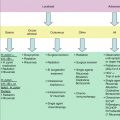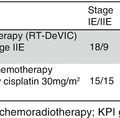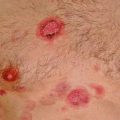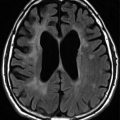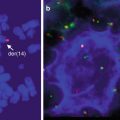Author (year)
n
PFS
OS
SMZL
Thieblemont et al. (2002)
81
Presence of M-component
Beta2 microglobulin ≥3 mg/L
Presence of animmunological event
Leukocytes ≥20 109/L
Lymphocytosis ≥9 109/L
Presence of M-component
Presence of an immunological event
Ruiz-Ballesteros et al. (2005)
–
Expression of CD38
Unmutated Ig-VH gene status
Expression of NF-κB-activatedgenes by GEP
Arcaini et al. (2006b)
309
–
Hemoglobin <12 g/dL
Elevated LDH
Albumin >3.5 g/dL
NMZL
Camacho et al. (2003)
27
Survivin
Cyclin E
Caspase 3
Petit et al. (2005)
12
–
Ki67
IRF4
Oh et al. (2006)
36
Age >60
B symptoms
Elevated LDH
ECOG ≥2
Hb <12 g/dL
Hb <12 g/dL
BM+
BM+
No anthracycline
Stage III/IV
ECOG ≥2
Stage III/IV
Traverse-Glehen et al. (2006)
21
None
None
47
B symptoms
Age >60
Hb <12 g/dL
Elevated LDH
BM+
HCV+
Kojima et al. (2007)
65
–
Age >60
Histological transformation to large-cell lymphoma remains uncommon, occurring in 10–20 % of patients. Diffuse large B-cell lymphoma, when involving the spleen, usually is characterized by one or several large nodules, very rarely involving the bone marrow. Transformation occurs within a median interval ranging from 12 to 85 months (Camacho et al. 2001). This presents clinically with the appearance of general symptoms, increase in LDH level, and disseminated lymphoma involvement. After histological progression, the median survival time was shortened to 26 months (Thieblemont et al. 2002).
13.4.4 New Treatment Strategies in SMZL
Treatment is required only in symptomatic patients with painful splenomegaly, with or without associated cytopenia due to hypersplenism. Asymptomatic patients, which represent a large percentage of the patients, can be appropriately managed with watchful waiting for several years. Withholding treatment does not influence the course of disease, and these patients often have stable disease for at least 10 years (Traverse-Glehen et al. 2006). The only exception to this management approach is in the setting of SMZL associated with active HCV infection. Antiviral therapy with pegylated interferon-α and ribavirin will lead to clearance of HCV RNA in 75 % of the patients and in concomitant clinical remission of the lymphoma (Vallisa et al. 2005) (Table13.2).
Table 13.2
Response to treatment in SMZL
Author (year) | n | Schedule | Statusof disease | Responserate (%) | CR/CRu (%) | PR (%) | PFS (at n years) | OS (at n years) |
|---|---|---|---|---|---|---|---|---|
Splenectomy alone | ||||||||
Chacon et al. (2002) | 29 | – | First line | 100 | 0 | 100 | * | * |
Thieblemont et al. (2003) | 25 | – | First line | 100 | 0 | 100 | 71 % (2) | 81 % (5) |
Chemotherapy alone | ||||||||
Lefrere et al. (2000) | 10 | Fludarabine | Relapsed | 100 | 70 | 30 | 42 % (4.7). | 50 % (5) |
Cervetti et al. (2004) | 50 | 2-Cda, 5 mg/m2,once a week × 6 | First lineor relapsed | 63 | 62 | – | 83 % (2) | NA |
Rituximab alone | ||||||||
Tsimberidou et al. (2006) | 26 | R once/W × 4 or 8 | First line | 88 | 43 | 46 | 86 % (3) | 95 % (3) |
Kalpadakis et al. (2007) | 16 | R once/W × 6 | First line | 100 | 79 | 11 | 92 % (2.1) | 100 % (3) |
Bennett et al. (2005) | 14 | R once/W × 4 | First line | 78 | 57 | 21 | 60 % (6) | 80 % (6) |
Rituximab and chemotherapy | ||||||||
Tsimberidou et al. (2004) | 6 | R-FMD or RFC | First line | 83 | 34 | 50 | 100 % (3) | 100 % (3) |
Arcaini et al. (2004) | 3 | R-CVP | First line | 100 | – | – | 100 % (1.3) | 100 % (1.3) |
When patients become symptomatic because of anemia, abdominal pain, or thrombocytopenia (Arcaini et al. 2006b), several treatment options may be proposed to the patient. Regarding cytopenia, the level of cytopenia to start treatment is not defined precisely in any retrospective studies, and, except for specific clinical trial, the decision of treatment should be taken on symptoms. As first option, splenectomy will rapidly improve performance status and correct anemia, thrombocytopenia, and neutropenia within 6 months after splenectomy (Thieblemont et al. 2003). This improvement is maintained for years with a median period of freedom from treatment of 8 years, even if bone marrow and blood lymphocytosis persist, suggesting a partial response. Following splenectomy, adjuvant chemotherapy provides an increased remission rate without modifying relapse-free and overall survival (Thieblemont et al. 2002). For patients who are unfit for splenectomy or unwilling to undergo surgery, systemic therapy may be effective (Table 13.3). Rituximab alone is reported to afford excellent response rate with a shorter PFS than that observed when rituximab is combined with cladribine or fludarabine or polychemotherapy (Arcaini et al. 2004; Thieblemont et al. 2003; Chacon et al. 2002; Kalpadakis et al. 2007; Lefrere et al. 2000; Tsimberidou et al. 2006; Bennett et al. 2005; Cervetti et al. 2004). Recently, bendamustine has emerged as a highly effective drug for NHL, including marginal zone lymphomas (Cheson et al. 2010). A European trial for the evaluation of combined rituximab and bendamustine for symptomatic SMZL patients has been recently opened (EudraCT number 2011-000880-28). For clinical trials to be evaluated, it is necessary to develop consistent staging and response criteria for the disease. The recent workshop of the European MZL group has redefined these parameters (Matutes et al. 2008).
Table 13.3
Median progression and overall survival in the published series of patients with NMZL
Author (year) | Numberof patients (n) | Medianprogression (years) | MedianOS (years) | 5-yearOS (%) |
|---|---|---|---|---|
Armitage andWeisenburger (1998) | 25 | Nd | Nd | 57 |
Nathwani et al. (1999b) | 20 | Nd | Nd | 56 |
Berger et al. (2000) | 37 | Nd | Nd | 55 |
Camacho et al. (2003) | 22 | Nd | Nd | 79 |
Arcaini et al. (2004) | 9 | 2.8 | Not reached | Nd |
Traverse-Glehen et al. (2006) | 21 | 1.3 | Nd | 64 |
Oh et al. (2006) | 36 | 1.3 | 5.5 | 82.7 |
Arcaini et al. (2007b) | 47 | 2.6 | Not reached | 69 |
Kojima et al. (2007) | 65 | Nd | Nd | 85 |
13.5 Nodal Marginal Zone Lymphoma
13.5.1 Clinical Presentation
Given the rarity of this disease and the absence of clinical prospective trial, description of clinical features of NMZL is based on few reports with relatively small numbers of patients (Berger et al. 2000; Traverse-Glehen et al. 2006; Arcaini et al. 2004, 2007b; Armitage and Weisenburger 1998; Camacho et al. 2003; Nathwani et al. 1999a; Oh et al. 2006; Kojima et al. 2007). The median age is 50–64 years, and the sex ratio differs from one series to the next. The vast majority of patients present with disseminated peripheral, abdominal, and thoracic nodal involvement, with a good performance status and no B symptoms. Bone marrow involvement is usually less prominent than in SMZL observed in 19–62 % of the patients. Peripheral blood involvement is rare and cytopenias are rare. A serum M-component is unfrequently detected (10 % of the patients). Cryoglobulin may be present when associated with HCV infection (Arcaini et al. 2007a). HCV seroprevalence was reported in 24 % of patients in a series from Italy, in 20 % of patients from Spain, and in 5 % from Korea. In contrast with the other MZL entities, there is no history of autoimmune disease in most patients with NMZL.
13.5.2 Pathological Features
13.5.2.1 Morphology
The morphologic features of NMZL are very heterogeneous in terms of both architecture and cytology (Traverse-Glehen et al. 2012). Different patterns of lymph node infiltration have been reported, including marginal zone-like/perifollicular, “inverse follicular,” perisinusoidal, follicular via colonization of reactive follicles, and diffuse (Arcaini et al. 2009a). A combination of different patterns in a single case is a common finding. Unlike in MALT lymphoma and splenic MZL, the neoplastic population often contains a relatively high number (more than 20 %) of large blastic B cells, and the mitotic index is frequent elevated as well.
Stay updated, free articles. Join our Telegram channel

Full access? Get Clinical Tree



